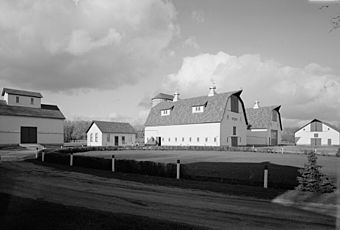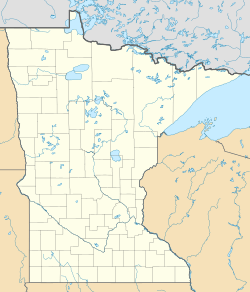Femco Farms facts for kids
Quick facts for kids |
|
|
Femco Farm No. 2
|
|

Femco Farm No. 2 viewed from the southwest in 1990
|
|
| Location | County Road 153, Roberts Township, Minnesota |
|---|---|
| Nearest city | Kent, Minnesota |
| Area | 7 acres (2.8 ha) |
| Built | 1922 |
| Architectural style | No style |
| MPS | Wilkin County MRA |
| NRHP reference No. | 80002184 |
| Added to NRHP | July 17, 1980 |
The Femco Farms were a group of five special farms in Wilkin County, Minnesota. They were started in the 1920s and 1930s. The main goal was to try out new ways of raising animals and growing different crops.
Frederick E. Murphy, who published the Minneapolis Tribune newspaper, created these farms. He wanted to show farmers better methods, like changing which crops they grew each year (called crop rotation). The Femco Farms became very well-known for their new ideas. They were especially famous for their amazing dairy cows, which produced a lot of milk.
Femco Farm No. 2 is the best-kept of these five farms. It was added to the National Register of Historic Places in 1980. This was because it was very important to the history of farming in the area.
Contents
History of Femco Farms
Why the Farms Started
In 1918, a doctor told newspaper publisher Frederick E. Murphy to spend more time outdoors. He was not feeling well. So, Murphy moved from Minneapolis to his wife's family farm in Wilkin County.
Murphy had always wanted to try new farming ideas. He started buying farms in the area. Soon, he owned five farms in Wilkin County. They covered about 5,000 acres (2,000 ha) of land. He named them "Femco," using the first letters of his own name.
What They Grew and Raised
The Femco Farms grew many different crops. These included oats, barley, corn, alfalfa, sweet clover, rye, and flax.
Even more important, Murphy only bought purebred animals. These included Percheron horses, Duroc Jersey hogs, McKarrow Shropshire sheep, white Orpington chickens, and Holstein dairy cows.
The farms tested new ways to raise animals. They also tried different methods for crop rotation and making the soil richer. Murphy wanted farmers to grow many different crops, not just a few main ones. He believed this "diversified farming" would help solve many farming problems of that time.
Famous Dairy Cows
The Femco Farms were most famous for their dairy cows. These cows won many awards.
One Holstein cow, named Lady Pride, was shown at the 1932 Minnesota State Fair. At that time, she produced more butter than any other cow. In one year, she gave 35,626 pounds (16,160 kg) of milk and 1,483 pounds (673 kg) of butter. The average cow back then only gave about 4,000 pounds (1,800 kg) of milk and 170 pounds (77 kg) of butter.
Another Holstein cow, Daisy Aaggie Ormsby III, set a new record. She produced 1,607 pounds (729 kg) of butter in a year. Murphy said that regular farmers could get the same great results if they used his methods.
After Frederick Murphy
Murphy became the president of the Minneapolis Tribune in 1921. He then moved back to Minneapolis. After he passed away in 1940, the Femco Farm properties were sold to different owners. His award-winning dairy cows were also sold. Some cows were bought for as much as $4,000 each. That was a lot of money back then!
Location of the Farms
The first Femco Farm, No. 1, is about five miles (8 km) north of Breckenridge, Minnesota. You can easily see its buildings from U.S. Route 75, even though they are quite old now.
Femco Farm No. 2 is in Roberts Township. It is just north of Kent.
The other farms were located in different townships nearby. Farm No. 3 was in Mitchell Township. Farm No. 4 was just north of Farm No. 1. Farm No. 5 was in Manston Township. There was also a sixth property, called Femco No Number, where the farms' manager lived. It was one mile north of Breckenridge.
Femco Farm No. 2 Details
Femco Farm No. 2 covered 1,200 acres (490 ha) of land. It was started in 1922. Twelve buildings were built that year or soon after.
When the farm was nominated for the National Register in 1979, many of the original buildings were still there. These included the foreman's house, workers' house, a granary, milk house, dairy barn, silo, hog barn, sheep barn, horse barn, and machine shed.
Three original buildings were no longer there. These were a chicken coop, a windmill, and a guest house for Murphy.
The dairy barn is very special. It has two large wings with a unique "gambrel" roof shape. These wings are connected by a hallway, which also has a gambrel roof.
Femco Farm No. 2 was chosen for the National Register of Historic Places because it was the best-preserved of all the Femco Farms. These farms had a "lasting impact" on farming in Wilkin County. Their special breeding animals also influenced farming across the United States.



